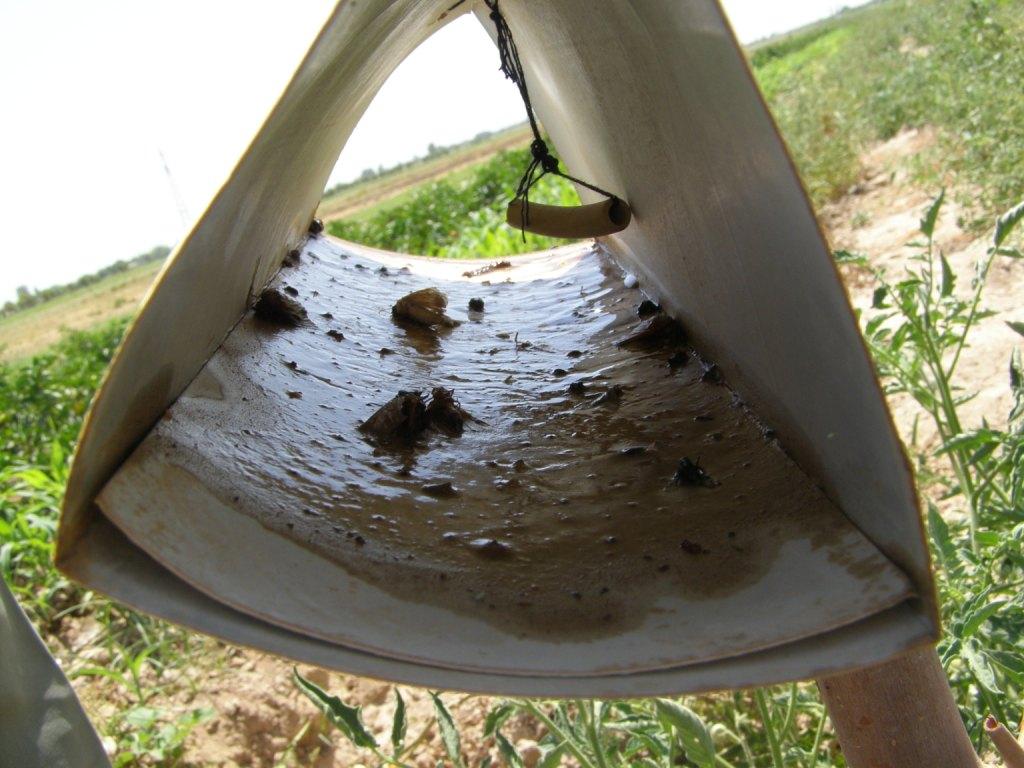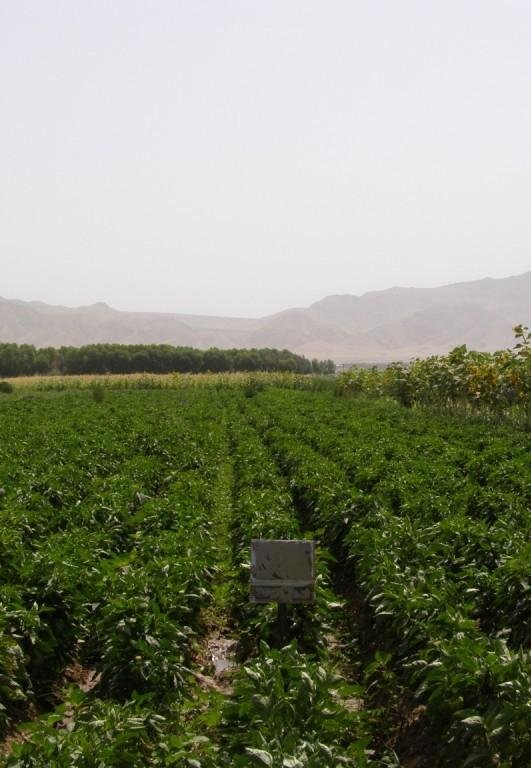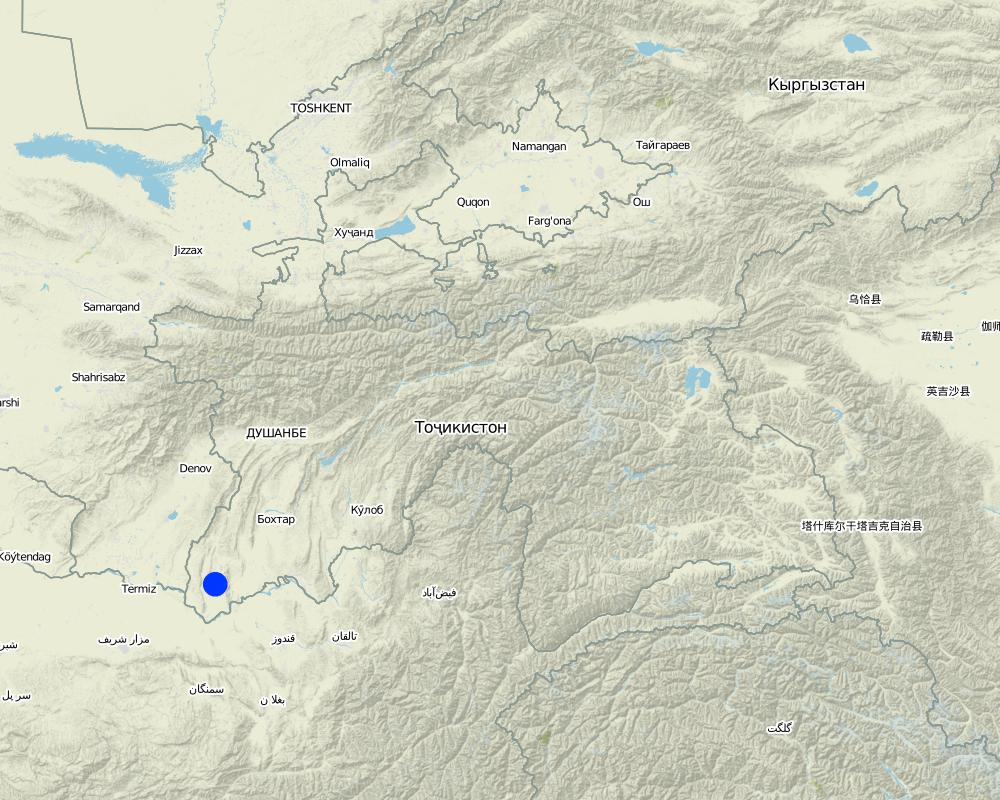Pest management with pheromone insect traps [塔吉克斯坦]
- 创建:
- 更新:
- 编制者: Firdavs Faizulloev
- 编辑者: –
- 审查者: David Streiff, Alexandra Gavilano
Tajikistan - Central Asian Countries Initiative for Land Management (CACILM/ИСЦАУЗР)
technologies_1054 - 塔吉克斯坦
查看章节
全部展开 全部收起1. 一般信息
1.2 参与该技术评估和文件编制的资源人员和机构的联系方式
SLM专业人员:
SLM专业人员:
SLM专业人员:
Urakov Buran
UNDP
塔吉克斯坦
有助于对技术进行记录/评估的机构名称(如相关)
United Nations Development Program (United Nations Development Program) - 塔吉克斯坦有助于对技术进行记录/评估的机构名称(如相关)
CDE Centre for Development and Environment (CDE Centre for Development and Environment) - 瑞士有助于对技术进行记录/评估的机构名称(如相关)
Central Asian Countries Initiative for Sustainable Land Management - Multicountry Capacity Building (CACILM - MCB) - 吉尔吉斯斯坦1.3 关于使用通过WOCAT记录的数据的条件
编制者和关键资源人员接受有关使用通过WOCAT记录数据的条件。:
是
2. SLM技术的说明
2.1 技术简介
技术定义:
Coloured pheromone traps are set up in agricultural fields to attract and eradicate flying insect pests.
2.2 技术的详细说明
说明:
Within the UNDP Farmer Field Schools, farmers were taught about how to use pheromone insect traps to combat insect pests in crop fields. In the past, people used to irrigate their fields in winter with ice-cooled water, or to apply deep ploughing in order to kill pests. According to local people, the winters in the Shaartuz area are getting shorter so it is difficult to apply these practices any more, and they cannot afford to pay for the ploughing devices they need, and therefore pests are spreading.
Purpose of the Technology: The purpose of these traps is to attract flying insects which might constitute crop pests by sending out pheromones and to kill them once in the trap. The main insect pests against which the traps are used include caradrina and other moths from the Noctuidae family, thrips, aphids, whiteflies and mole crickets.
Establishment / maintenance activities and inputs: The trap consists of a wooden body, covered with plastic sheets to protect it from the rain. The exterior is painted in yellow to make it more attractive the insects. Inside the plate, a small tube is fitted which sends out pheromones to attract insects and the floor is covered with a plate covered with a mix of glue and Vaseline to trap the insects. As an alternative to Vaseline, motor oil can also be used. The trap is set up in early May and the sticky plate has to be changed once every two months.
Natural / human environment: This technology is used in fields of tomatoes, watermelon, onion, pumpkin, beans, corn, wheat and sweet pepper. As it is very cheap and simple to establish, there is a strong adoption trend seen among farmers. The pheromone insect traps provide an effective replacement for expensive chemical insecticides. However, the trap is only works for flying insects and methods to combat other arthropod pests still need more testing.
2.3 技术照片
2.5 已应用该技术的、本评估所涵盖的国家/地区/地点
国家:
塔吉克斯坦
区域/州/省:
Khatlon
有关地点的进一步说明:
Kabodion
具体说明该技术的分布:
- 均匀地分布在一个区域
如果不知道精确的区域,请注明大致覆盖的区域:
- 10-100 平方千米
注释:
Total area covered by the SLM Technology is 60 km2.
Around 160 farmers are using the technology distributed over 4 Jamoats:
Hudoiqulov Jamoat - 2700 ha,
Nuri Vakhsh Jamoat - 1156 ha,
Telman Jamoat -1450 ha,
Jura Nazarov Jamoat -1200 ha
Map
×2.6 实施日期
如果不知道确切的年份,请说明大概的日期:
- 10-50年前
2.7 技术介绍
详细说明该技术是如何引入的:
- 在实验/研究期间
3. SLM技术的分类
3.1 该技术的主要目的
- reduce cost for inputs
3.2 应用该技术的当前土地利用类型

农田
- 一年一作
年作 - 具体指明作物:
- 豆科牧草和豆类 - 豆子
- 谷类 - 小麦(春季)
- 蔬菜 - 根茎类蔬菜(胡萝卜、洋葱、甜菜等)
- Tomatoes, Pumpkin, Watermelon, Sweet Pepper, Corn
每年的生长季节数:
- 1
具体说明:
Longest growing period in days: 240Longest growing period from month to month: March-October
注释:
Major land use problems (land users’ perception): wind erosion, aridity, low soil fertility, increasing impacts of climate change, pests
3.4 供水
该技术所应用土地的供水:
- 混合雨水灌溉
3.5 该技术所属的SLM组
- 病虫害综合管理(包括有机农业)
3.6 包含该技术的可持续土地管理措施

农艺措施
- A7:其它
注释:
Main measures: agronomic measures
3.7 该技术强调的主要土地退化类型

生物性退化
- Bp:害虫/疾病增加,捕食者减少
注释:
Main type of degradation addressed: Bp: increase of pests / diseases, loss of predators
Main causes of degradation: soil management (Irrigation with icy water in winter would be required but is not done any longer), change in temperature (warmer winters)
3.8 防止、减少或恢复土地退化
具体数量名该技术与土地退化有关的目标:
- 防止土地退化
注释:
Main goals: prevention of land degradation
4. 技术规范、实施活动、投入和成本
4.1 该技术的技术图纸
技术规范(与技术图纸相关):
Technical knowledge required for field staff / advisors: low
Technical knowledge required for land users: low
Main technical functions: control of pests
Agronomic measure: pest control
Material/ species: plastic pheromone traps
Quantity/ density: 4
Remarks: 4 traps per hectare
4.2 有关投入和成本计算的一般信息
具体说明成本计算所用货币:
- 美元
4.3 技术建立活动
| 活动 | 时间(季度) | |
|---|---|---|
| 1. | Set up insect trap | early May |
4.4 技术建立所需要的费用和投入
| 对投入进行具体说明 | 单位 | 数量 | 单位成本 | 每项投入的总成本 | 土地使用者承担的成本% | |
|---|---|---|---|---|---|---|
| 设备 | Buying traps | pieces | 4.0 | 4.0 | 16.0 | 100.0 |
| 技术建立所需总成本 | 16.0 | |||||
| 技术建立总成本,美元 | 16.0 | |||||
注释:
4 traps per ha
4.5 维护/经常性活动
| 活动 | 时间/频率 | |
|---|---|---|
| 1. | Change glue on plate | once every two months |
| 2. | None | None |
4.6 维护/经常性活动所需要的费用和投入(每年)
| 对投入进行具体说明 | 单位 | 数量 | 单位成本 | 每项投入的总成本 | 土地使用者承担的成本% | |
|---|---|---|---|---|---|---|
| 劳动力 | Change glue on plate | - | 1.0 |
注释:
Machinery/ tools: plastic plates, yellow colour, glue, vaseline, motor oil, pheromone tube
The costs mentioned apply to the set-up of 4 traps per hectare and include all materials used
5. 自然和人文环境
5.1 气候
年降雨量
- < 250毫米
- 251-500毫米
- 501-750毫米
- 751-1,000毫米
- 1,001-1,500毫米
- 1,501-2,000毫米
- 2,001-3,000毫米
- 3,001-4,000毫米
- > 4,000毫米
农业气候带
- 干旱
Thermal climate class: temperate
5.2 地形
平均坡度:
- 水平(0-2%)
- 缓降(3-5%)
- 平缓(6-10%)
- 滚坡(11-15%)
- 崎岖(16-30%)
- 陡峭(31-60%)
- 非常陡峭(>60%)
地形:
- 高原/平原
- 山脊
- 山坡
- 山地斜坡
- 麓坡
- 谷底
垂直分布带:
- 0-100 m a.s.l.
- 101-500 m a.s.l.
- 501-1,000 m a.s.l.
- 1,001-1,500 m a.s.l.
- 1,501-2,000 m a.s.l.
- 2,001-2,500 m a.s.l.
- 2,501-3,000 m a.s.l.
- 3,001-4,000 m a.s.l.
- > 4,000 m a.s.l.
5.3 土壤
平均土层深度:
- 非常浅(0-20厘米)
- 浅(21-50厘米)
- 中等深度(51-80厘米)
- 深(81-120厘米)
- 非常深(> 120厘米)
土壤质地(表土):
- 粗粒/轻(砂质)
表土有机质:
- 低(<1%)
如有可能,附上完整的土壤描述或具体说明可用的信息,例如土壤类型、土壤酸碱度、阳离子交换能力、氮、盐度等。:
Soil fertility is very low
Soil drainage / infiltration is good
Soil water storage capacity is very low
5.4 水资源可用性和质量
地表水的可用性:
匮乏/没有
水质(未处理):
不良饮用水(需要处理)
关于水质和水量的注释和进一步规范:
poor drinking water (treatment required)= groundwater
5.5 生物多样性
物种多样性:
- 低
5.6 应用该技术的土地使用者的特征
生产系统的市场定位:
- 混合(生计/商业)
非农收入:
- 低于全部收入的10%
个人或集体:
- 个人/家庭
机械化水平:
- 机械化/电动
性别:
- 女人
- 男人
说明土地使用者的其他有关特征:
Land users applying the Technology are mainly common / average land users
Population density: 50-100 persons/km2
Annual population growth: 2% - 3%
5.7 应用该技术的土地使用者使用的平均土地面积
- < 0.5 公顷
- 0.5-1 公顷
- 1-2 公顷
- 2-5公顷
- 5-15公顷
- 15-50公顷
- 50-100公顷
- 100-500公顷
- 500-1,000公顷
- 1,000-10,000公顷
- > 10,000公顷
这被认为是小规模、中规模还是大规模的(参照当地实际情况)?:
- 中等规模的
注释:
Average area of land owned or leased by land users applying the Technology also 50-100 ha
5.8 土地所有权、土地使用权和水使用权
土地所有权:
- 州
土地使用权:
- 租赁
5.9 进入服务和基础设施的通道
健康:
- 贫瘠
- 适度的
- 好
教育:
- 贫瘠
- 适度的
- 好
技术援助:
- 贫瘠
- 适度的
- 好
就业(例如非农):
- 贫瘠
- 适度的
- 好
市场:
- 贫瘠
- 适度的
- 好
能源:
- 贫瘠
- 适度的
- 好
道路和交通:
- 贫瘠
- 适度的
- 好
饮用水和卫生设施:
- 贫瘠
- 适度的
- 好
金融服务:
- 贫瘠
- 适度的
- 好
6. 影响和结论性说明
6.1 该技术的现场影响
社会经济效应
生产
生产故障风险
收入和成本
农业投入费用
注释/具体说明:
pesticides
社会文化影响
食品安全/自给自足
Livelihood and human well-being
生态影响
生物多样性:植被、动物
害虫/疾病控制
6.3 技术对渐变气候以及与气候相关的极端情况/灾害的暴露和敏感性(土地使用者认为的极端情况/灾害)
渐变气候
渐变气候
| 季节 | 增加或减少 | 该技术是如何应对的? | |
|---|---|---|---|
| 年温度 | 增加 | 好 |
气候有关的极端情况(灾害)
气象灾害
| 该技术是如何应对的? | |
|---|---|
| 局地暴雨 | 好 |
| 局地风暴 | 不好 |
气候灾害
| 该技术是如何应对的? | |
|---|---|
| 干旱 | 好 |
水文灾害
| 该技术是如何应对的? | |
|---|---|
| 比较和缓的(河道)洪水 | 好 |
其他气候相关的后果
其他气候相关的后果
| 该技术是如何应对的? | |
|---|---|
| 缩短生长期 | 好 |
| hail | 不好 |
注释:
a cover could be applied to the trap to protect it from hail
6.4 成本效益分析
技术收益与技术建立成本相比如何(从土地使用者的角度看)?
短期回报:
积极
长期回报:
积极
技术收益与技术维护成本/经常性成本相比如何(从土地使用者的角度看)?
短期回报:
非常积极
长期回报:
非常积极
6.5 技术采用
- 1-10%
如若可行,进行量化(住户数量和/或覆盖面积):
160 household in an area of 60 km^2 (density 50-100 persons/km^2)
在所有采用这项技术的人当中,有多少人是自发的,即未获得任何物质奖励/付款?:
- 91-100%
注释:
100% of land user families have adopted the Technology without any external material support
160 land user families have adopted the Technology without any external material support
Comments on spontaneous adoption: The technology was shown to the farmers in the Farmer Field Schools, and as a result many adopted the techniques and built traps for themselves.
There is a strong trend towards spontaneous adoption of the Technology
6.7 该技术的优点/长处/机会
| 土地使用者眼中的长处/优势/机会 |
|---|
| Effective pest control |
| Very cheap and simple to apply technology |
| 编制者或其他关键资源人员认为的长处/优势/机会 |
|---|
|
Biological pest control How can they be sustained / enhanced? Arrange for farmer to farmer visits to disseminate information. |
6.8 技术的弱点/缺点/风险及其克服方法
| 土地使用者认为的弱点/缺点/风险 | 如何克服它们? |
|---|---|
| The trap only attracts flying insects, but does not help to kill other types of pests | Develop technologies to control caterpillars etc. |
| The small pheromone tube that is used in the setup of the trap is more and more difficult to find in the local chemist shops |
| 编制者或其他关键资源人员认为的弱点/缺点/风险 | 如何克服它们? |
|---|---|
| The trap does not differentiate between flying insects, so it is possible that it will also catch beneficial insects as well as pests. |
7. 参考和链接
7.1 信息的方法/来源
链接和模块
全部展开 全部收起链接
无链接
模块
无模块





